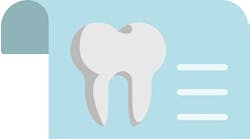By Donald Crumb, DDS
For more on this topic, go to www.dentaleconomics.com and search using the following key words: dental emergencies, dental triage, emergency appointments, Dr. Donald Crumb.
The telephone rings just before closing and the appointment coordinator reluctantly answers. Mrs. Jones, a longtime patient, says that her front crown fell off and she has a very important meeting in the morning. The doctor just left for the day, so Mrs. Jones is scheduled for 7:45 a.m. before the doctor’s first scheduled patient at 8 a.m.
The next day she arrives and is seated at 7:55 a.m. After a quick exam and looking at the crown, the doctor realizes that the post is broken and there is nothing left in the mouth to cement the crown onto. The dentist removes the fractured tooth structure and post from the inside of the crown, inserts a few pins in the root, and at 8:40 a.m. temporarily cements the crown. The stress level in the treatment room is high as the 8 a.m. patient does not like to be kept waiting.
Life can be easier for everyone if the first step of the emergency treatment process, comprehensive triage, is accomplished by the front office staff during the initial telephone call. Ideally, this is when the emergency problem is identified, prioritized, and scheduled. Comprehensive triage over the phone is very challenging, even to team members with extensive dental experience.
When a dentist listens to an "emergency" patient describe his or her symptoms chairside, after the benefit of the additional information gleaned from diagnostic radiographs and a clinical exam, more often than not everything makes sense. A diagnosis is made and the appropriate treatment is rendered.
It is very difficult to teach a staff person, regardless of how intuitive he or she is, how to think like an experienced dentist during these phone conversations. If logical questions are not asked, there will be no logical answers, and conclusions will be illogical.
Consider sorting dental problems into the following categories: denture problems, tooth and crown fractures, crowns and bridges off, trauma, and pain of unknown etiology. Once the problem has been sorted into one of these categories, there is certain information that is relevant to each category and certain information that is common to more than one category.
Common information – Common information includes the patient’s name, date of call, and name of person taking the call. Is this a patient of record or new? Where is the problem? How long has it existed? Does it hurt? Is it a cosmetic problem? What dental treatment has been done in the area? Does the patient require premedication for dental work?
More category-specific information:
Denture problems – Type of denture? How old is it? Has the denture been relined? When? Does the patient have a spare denture?
Tooth and crown fractures – Does the fracture involve a crown or tooth? Is there any tooth left? What caused the fracture? Is there a problem with food impaction? Does the crown feel loose?
Crown and bridges off – Is the crown/bridge temporary or permanent? What is inside of the crown/bridge abutment? Is the crown/bridge broken?
Trauma – Did the patient go to the emergency room? If so, were X-rays taken? Is there any bleeding? Were any teeth knocked out? If so, does the patient have the teeth? Do the teeth come together normally when closing? Can the mouth open as wide as usual?
Pain of unknown etiology – What is the intensity of the pain on a scale of 0 to 10? Is the patient taking any medication to relieve the pain? What meds and what dosage? Do the meds relieve the pain? Is the pain getting better, staying the same, or getting worse? Is there pain to hot or cold liquids? Does the pain go away after the hot or cold is removed? Is the pain spontaneous? Is there pain to biting pressure? Is there any swelling? Is the pain dull or sharp?
Every dental office has to find a way to deal with dental emergencies. There is no single solution that will work for every office, but doesn’t it make good sense to get as much information as you can about a patient’s problem before he or she arrives at your office?
The first step in the successful management of a dental emergency is the triage and scheduling process that should occur during the initial telephone call. Patients are very appreciative when their "emergencies" are managed in a professional manner and their problems are resolved satisfactorily. They become some of the best advocates for your practice.
Dr. Donald Crumb has practiced general dentistry in Syracuse, N.Y., since 1976. He is the founder of Crumb’s Cranium, LLC, which has introduced the only intuitive dental triage software that enables front office staff to effectively manage and schedule dental emergencies. For information, go to crumbscranium.com or contact Dr. Crumb at [email protected].
Past DE Issues





